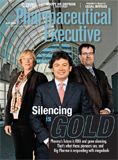Tough Nut to Crack
Pharmaceutical Executive
An innovative approach bridges the pediatric communication gap
It certainly isn't news that physicians are stretched thin. They're too busy (and increasingly, too skeptical) to see pharmaceutical sales reps and listen to well-crafted details about brands. Yet even though they're restricting time with reps, physicians have less and less time to spend with patients during office visits. In fact, a 2000 study ("Managed Care, Time Pressure, and Physician job Satisfaction) found that 83 percent of family physicians in HMO settings, and 54 percent of family physicians in small group practices reported needing more time per patient visit.
The problem is further compounded for physicians treating pediatric patients, as they face a unique set of challenges. Not only do they struggle to find enough time with patients during office visits, they must also work to help parents understand the child's condition and response to treatment.
The Communication Gap
Parents are often unsure how to assess and track their child's response to medication. That difficulty can result in an increased burden on the treating physician during the examination and follow-up visits. Worse yet, because of the volume of activity in today's typical medical practice, physicians often only have enough time to provide a quick synopsis of the child's condition and treatment before the patient and their parents depart. There is usually no communication until the next office visit, so physicians are left with numerous questions, such as:
- Did the parent understand the diagnosis?
- Will the parent fill the prescription?
- Did they understand and are they following the dosing schedule?
- Is that medication the right one for this patient?
- How is the child responding to treatment?
- Will the parent be able to identify and discuss signs of progress and response to treatment?
Even at the follow-up visit, these answers can be difficult to ascertain. In between office visits, parents may underestimate the importance of consistent treatment. In addition, during this "communication gap," parents are often unsure of what to look for, what questions to ask their children, and what information will be most helpful to the physician in discussing treatment progress. Imagine the difficulty of such a discussion during a time-compressed office visit, and you begin to recognize the unique challenge of the pediatric patient–physician dynamic.

Tom McDonnell
Obtaining Patient Feedback
Together, Infomedics and Shire decided to address these challenges head-on while developing launch plans for a new ADHD treatment in an extremely competitive marketplace. The plan's aim was to go beyond traditional brand launch activities in order to reach physicians and make a deep impression on them. The launch plan included a program designed to deliver detailed patient feedback, and facilitate better communications between patient/parent and doctor.
Here's how it worked. Parents of ADHD patients received disease education materials and an invitation to join the Shire CRM program through product starter kits. Enrolled parents were then asked to complete three brief surveys taken during the pediatric patient's early experience with the medication, addressing a range of issues including satisfaction levels and symptom relief.
The parents' survey responses were then delivered directly to the prescribing physician in the form of an individual patient feedback report. With their survey responses in hand, physicians were able to quickly see the patient's treatment progress, level of satisfaction with the medication, symptom relief, impact on quality of life, and intent to continue on the medication. Reports not only brought the physician up to speed in between office visits on the patient's experience with the new drug, they helped to facilitate a more informed, efficient, and effective dialogue with the parent and child at the next visit. The surveys and resulting report provided a way for parents to know what they should be tracking and what the physician would be interested in knowing about the child's progress, making the conversation easier for both parent and physician.
The survey feedback also produced an important by-product: Physicians received positive affirmation of their prescribing decisions from their own patients. And the significance of this affirmation shouldn't be minimized; when making prescriptions, physicians typically rely on their training, online prescribing database tools, medical journals, clinical trial data, and previous experience. Usually, they only hear from patients when a medication is not working for them. They seldom receive real world confirmation that the patient's needs are being met.

Robert Bedford
With this feedback in hand, the physicians can now have a greater understanding when discussing treatment options and making decisions for other patients.
Loyalty Wins the Day
For Shire, the feedback program had an immediate and major impact on prescribing. An independent review by IMS Health compared a group of participating (test) physicians against a control group of non-participating physicians. They found that:
- The program increased prescribing within the first month of product launch, and quickly covered the costs of the program.
- The annualized ROI is greater than 8:1
- Physicians receiving patient reports significantly increased their market share vs. matched control physicians.
In addition, this novel approach established physician acceptance of the new therapy, with proof of patient response delivered through feedback reports. It also distinguished Shire as a manufacturer that understands the challenges patients/parents and physicians face treating ADHD. Shire representatives were excited to highlight the program to their physicians as a way to differentiate the brand from its competitors. Since representatives were not burdened with additional work around the program, they eagerly promoted the patient feedback program, which served as a positive reinforcement to their product detail. That allowed sales reps to follow up their messages with an offer to deliver early experience with the new product—and in so doing, show real confidence in the product.
Providing physicians with direct feedback from their own patients (or in this case, the patients' parents) enabled physicians and patients to talk candidly and constructively about the treatment and challenges of the condition. Everyone involved appreciated the ability to provide structured feedback about this new treatment option, which facilitates improved communications between patient and doctor, and can potentially improve health outcomes.
Tom McDonnell is Product Director for Vyvanse Marketing, Shire. He can be reached at tmcdonnell@shire.com
Robert Bedford is senior vice president, sales and client relations for InfoMedics. He can be reached at rbedford@infomedics.com
The Misinformation Maze: Navigating Public Health in the Digital Age
March 11th 2025Jennifer Butler, chief commercial officer of Pleio, discusses misinformation's threat to public health, where patients are turning for trustworthy health information, the industry's pivot to peer-to-patient strategies to educate patients, and more.
Navigating Distrust: Pharma in the Age of Social Media
February 18th 2025Ian Baer, Founder and CEO of Sooth, discusses how the growing distrust in social media will impact industry marketing strategies and the relationships between pharmaceutical companies and the patients they aim to serve. He also explains dark social, how to combat misinformation, closing the trust gap, and more.
